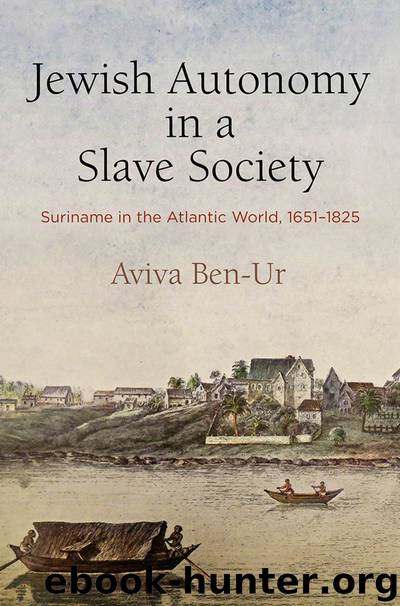Jewish Autonomy in a Slave Society by Aviva Ben-Ur

Author:Aviva Ben-Ur [Ben-Ur, Aviva]
Language: eng
Format: epub
ISBN: 9780812297041
Publisher: University of Pennsylvania Press, Inc.
Published: 2020-06-15T00:00:00+00:00
The Primacy of Purim for Portuguese Jews
The political and cultural hegemony of Portuguese Jews over Atlantic Jewry is critical in understanding Purim’s centrality among Jews in the Atlantic World. In the biblical narrative, Esther initially concealed her Jewish identity in order to marry the Persian king and then revealed her true origins to him in a plea to halt his planned genocide of her people. The collective experience of forced conversion and secret Judaism, initiated in the Iberian Peninsula in the late fourteenth through late fifteenth century, conditioned Portuguese Jews to identify with Esther, for, like them, she masqueraded as a non-Jew while never relinquishing her loyalty to her heritage and people. Miriam Bodian, author of a study of Portuguese Jews in early modern Amsterdam, attributes the “elevated status” of Purim among conversos in the Iberian Peninsula to their intense identification with Esther as an ancient crypto-Jew. For similar reasons, Cecil Roth argued almost a century ago that the Fast of Esther acquired among secret Jews an importance that “rivaled that of the Day of Atonement itself.”18 The popularity of Esther extended to the Iberian population as whole. Of all female figures in the Hebrew Bible, none received more attention in early modern Castilian texts than did Esther, particularly among conversos, while in Portugal she was considered the holiest of queens.19
This same heritage contributed to the enthusiasm for Purim in the open Jewish communities established by former crypto-Jews and their descendants in the Americas. A minor Jewish festival, Purim in Suriname rivaled all the major holidays of the Jewish calendar, including the hallowed Day of Atonement. While the Surinamese sources examined thus far include no mention of Purim fireworks, as witnessed in Curaçao, Suriname’s Jews gave primacy to the festival in other ways, equally conspicuous. Devotion to Purim was first and foremost institutionally reinforced. The mandated recitation of the Book of Esther in synagogue was beautified by a high-quality “Meguila” with large letters and marble handles enclosed within a brass box, a costly relic that the Mahamad’s regents specially ordered from Amsterdam in 1772, evidently to replace an older scroll that had worn out.20 In the 1780s, more candles illuminated Suriname’s two Portuguese synagogues on Purim than on an ordinary Friday night, and as many were lit as on a major holiday coinciding with Sabbath eve.21 This brilliant display of light—forty-eight lamps and four tapers—was a significant investment considering the unreliability and expense of candle shipments from across the Atlantic.22
Although Purim was a minor holiday halakhically speaking (work, for example, was technically permitted), Surinamese Jews carefully safeguarded its unhindered observance and did not hesitate to protest its encroachment by non-Jewish authorities, just as they periodically protested the infringement by colonial officials of major Jewish holidays and Sabbaths.23 In 1775, one concerned member of the Portuguese Jewish community asked the Mahamad to appeal to the commissioners of the Civil Court not to disturb “our individuals” by serving them sentences on the festival of Purim.24 In fact, the minutes record several dispensations
Download
This site does not store any files on its server. We only index and link to content provided by other sites. Please contact the content providers to delete copyright contents if any and email us, we'll remove relevant links or contents immediately.
Genius & Anxiety by Norman Lebrecht(770)
A Chosen Few by Mark Kurlansky(763)
The Aleppo Codex: A True Story of Obsession, Faith, and the Pursuit of an Ancient Bible by Matti Friedman(648)
Righteous Victims by Benny Morris(648)
A history of Zionism by Walter Laqueur(641)
Going Home by Raja Shehadeh(641)
The War Against the Jews: 1933–1945 by Lucy S. Dawidowicz(603)
Complete Works of Josephus by Josephus(584)
Rome and Jerusalem : the clash of ancient civilizations by Goodman Martin 1953-(549)
Legacy by Thomas Harding(549)
The Israel-Arab Reader by Walter Laqueur(545)
The Rise of the Roman Empire (Classics) by Polybius(530)
We Stand Divided by Daniel Gordis(515)
Tehran Children by Mikhal Dekel(485)
A History of Zionism by Walter Laqueur(484)
Ethics (Translated & Annotated) by Baruch Spinoza(481)
The Secret History by Procopius(479)
Jewish Terrorism in Israel by Pedahzur Ami & Arie Perliger(469)
The Rise of the Roman Empire by Polybius(463)
